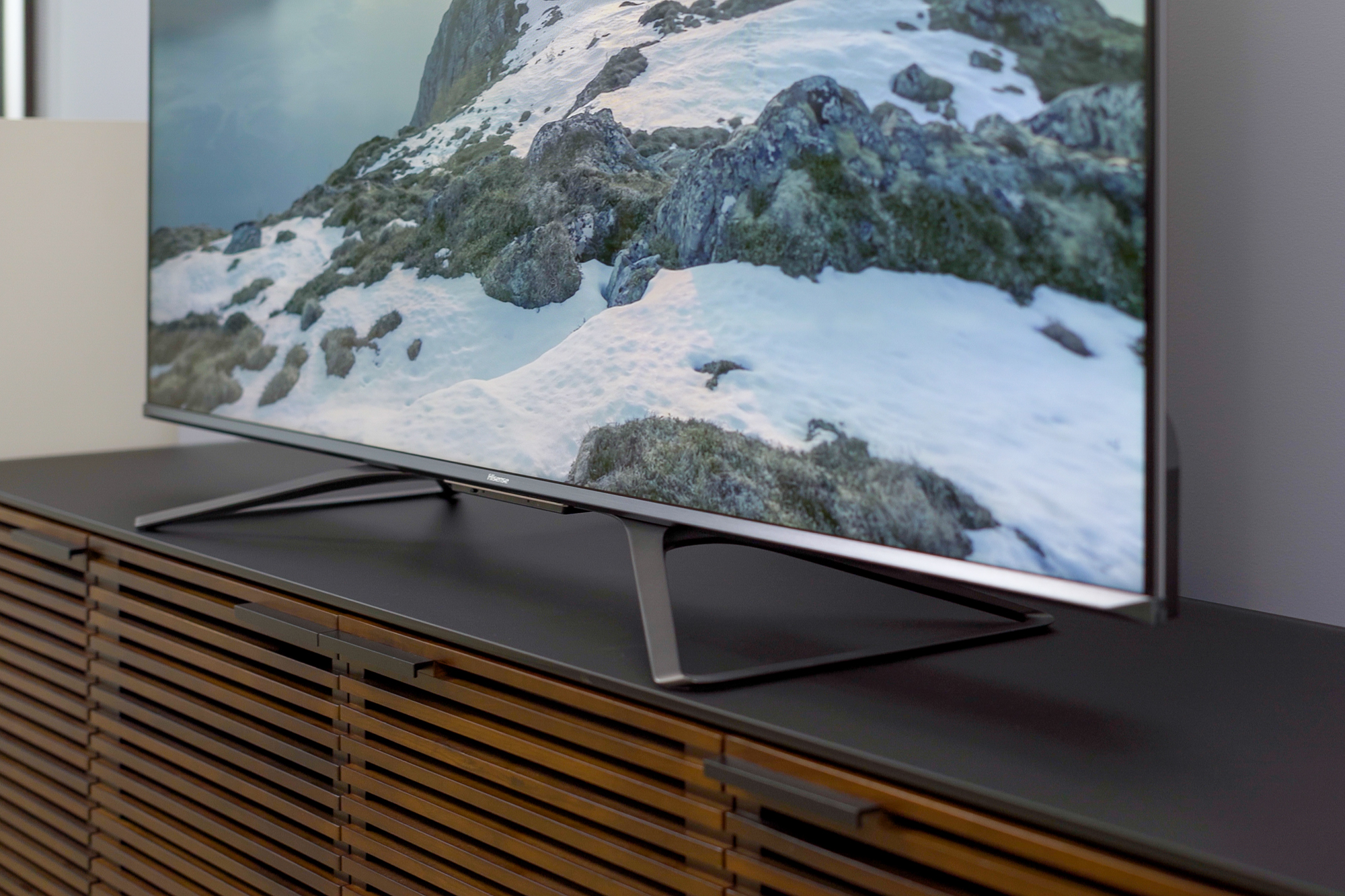- Incredible brightness
- Excellent black levels
- Vivid, bright colors
- Good motion
- Excellent for gaming
- Great sound
- Poor off-angle picture
- Low-luminance color issue
As a replacement for the highly popular Hisense H9G from 2020, the new Hisense U8G 4K ULED HDR TV has a lot to live up to. The two TVs look very similar, but it’s what’s inside that counts. The H9G was lauded for being particularly bright while maintaining impressive black levels, leading to high-contrast picture quality.
Will we see some upgrades and improved performance with this new model? I hope so, since the U8G costs quite a bit more than its predecessor. For example. the 65-inch H9G I reviewed in August 2020 debuted at $950, whereas the 65-inch U8G reviewed here costs $1,300.
In this review, I’ll get into peak brightness measurements, take a look at how the backlight is behaving, evaluate black levels, dig into color accuracy and customizations to the picture quality, and see if it all adds up to a TV you will want to buy.
Video review
Jump to: What is ULED | Out of the box | Setup | Connections | Picture settings | Calibration | Processing | Picture quality | Sound | Gaming | Our take
What is ULED?
Let’s start with the ULED moniker because I think that could be confusing for some folks. To be clear, this is a quantum dot TV, so it could just as easily be called a QLED TV. Hisense just has its own branding thing going on, so this TV is comparable to other LED-backlit QLED TVs on the market.
Out of the box

The Hisense U8G is effectively packaged and should be well-protected for transit. Not a whole lot is to be found in the box — you get the TV, two stand legs, screws for the legs, a slightly redesigned remote, batteries, and a composite video cable, along with product literature.
Connecting the TV’s legs is a piece of cake, and I appreciate the centralized stand that allows larger screen-size models to fit on a broader variety of stands.
The TV features very thin bezels, save the bottom border, which features a brushed metal strip. The TV doesn’t have a particularly thin profile, so it may not look as sleek on the wall as more expensive competing models.
Hisense U8G 4K ULED HDR details
While we reviewed the 65-inch 65U8G model, our review also applies to the 55-inch model.
| Screen Size | Model Number | MSRP |
| 55-inch |
55U8G
|
$899.99 |
| 65-inch | 65U8G | $1,149.99 |
Setup

The Hisense U8G runs Android TV as its operating system rather than the newer Google TV. This looks to be the status quo for now as apparently, Hisense has no immediate plans to support Google TV on its 2021 models, according to 9to5Google.
As an Android TV, setting up access to apps involves a lot of user IDs and passwords — there’s no getting around that. But if you choose to log in with your Google account, you’ll automatically be logged into your YouTube account as well.

Speaking of Google, the U8G is equipped with a microphone in the remote and another in the TV for calling up the Google Assistant. Be careful to choose the setting that allows hands-free
Connections

The Hisense U8G offers two HDMI 2.1 inputs, located in inputs HDMI 3 and 4. You’ll note each one is labeled to handle
It’s also important to dig into the picture settings menu, find HDMI Format, and select enhanced in order to unlock advanced features like variable refresh rate (VRR),
Picture settings

The out-of-box picture settings I chose (and would recommend to U8G owners) were Theater Day for SDR content,
From there, I disabled motion smoothing and made sure the set’s local dimming feature was set to high. I left most other settings at their default since they were set correctly for the picture presets I chose.
Calibration and measurements

As part of my calibrations and adjustments — for which I use Calman software and a SpectraCal C6 colorimeter profiled to an X-Rite i1Pro meter — I adjust a TV’s two-point white balance. This ensures that the TV is using the optimal blend of red, blue, and green primaries for better color accuracy.
With the H9G, I ran into an issue where I wasn’t able to make separate adjustments to SDR and
Once those adjustments were made, I measured the TV’s grayscale and peak brightness and ran a number of color tests.
In SDR, I measured just over 700 nits peak brightness, which is rather intense! Switching to
Bright colors look fantastic.
Those kind of brightness numbers are great, but you also want to see solid black levels. The good news is that the U8G’s black levels are as impressive as the H9G’s were, which is to say there is minimal blooming or halo when the TV is viewed directly on-axis. Once you step off to the side, though, those inky blacks are lost and the TV’s backlight tends to show itself. Blacks go milky, and there’s some color shift as well.
As for color, it’s kind of a mixed bag. Bright colors look fantastic. I found them to be well-saturated but not oversaturated, very rich, with impressive color gamut coverage. Low-luminance colors seem to struggle, though. Objectively, I could see this in the measurements — the dimmer the color, the more the color missed its target.
You don’t notice this often when viewing real content, but there were some times when the image did seem to have some dark, splotchy areas, which at first seemed to be the result of a panel uniformity issue, but on closer inspection actually seems to do with the backlight performance. Again, I didn’t see this often, but it popped up a few times with some of the content I’ve watched. Mostly, I saw the effect when watching an image slowly fade in — going from dark to bright. This resulted in a color-banding effect that was never present in brighter images. Something to keep in mind.
Otherwise, I found the U8G’s backlight very quick to respond — the TV has no problem with tardy dimming or brightening backlight response, which I have seen from some other TVs this year. So when something goes black, it can go black very quickly, and when an object lights up, it lights up immediately.
Processing
The level of detail on this TV is also very impressive. The U8G offers fine detail with minimal artifacting, passing most of our stress tests with ease. Very rarely do I see the moire effect or screen door effect on this TV. Also, this particular sample has a pretty clean LCD panel, I’m didn’t see any splotchiness or even much vignetting in the corners. It looks great for golf and hockey where you get a lot of green or white and it would be easy to see a dirty screen effect.
Motion is also impressive on the U8G. It’s got an excellent response time and it is also very bright, so you will see some stutter with slowly panning images. This can be ironed out by using a minimal amount of motion smoothing, but that may bring on soap opera effect, which cinephiles like myself tend to dislike. On the whole, though, the U8G offered surprisingly solid motion performance.
I think my one real complaint about this TV would be around some of the macroblocking I saw when watching low-bit-depth content, from highly compressed videos. I’d like the TV to clean that up a bit better. There were moments when I was watching YouTube and I could see a lot of macroblocking (big squares of color) in darker areas. Fortunately, though, higher-quality content doesn’t suffer from that. So your Netflix, Disney+, HBO Max, Blu-ray discs, and PC/console games will all look stellar.
Picture quality takeaway

Setting aside all of the objective measurements and analysis and simply sitting back and watching this TV, I found it was hard not to be impressed with the U8G — if you’re sitting right in front of it. Viewed dead-on, this TV is a real dazzler. The super-high contrast the U8G offers is reminiscent of OLED TVs in some ways, and you get that contrast no matter how much light is in the room due to its exceptional full-screen brightness.
Sound
Surprisingly enough, the U8G sounds very good! It’s got a respectable amount of bass, dialogue is always very clear, and the treble isn’t too harsh, though it does sparkle and offers a good amount of high-end detail. Definitely a bonus!
Gaming
This TV is extremely well-suited for gaming. It’s got a very low-input lag in game mode, the
Our take
I think it is safe to say that the Hisense U8G is definitely an over-achiever. It improves on the H9G in most meaningful ways. The price for this tier of TV has gone up a bit, but you get performance for the premium you pay. I think the value is very much there considering the U8G’s performance. I’m looking forward to doing some comparisons in the coming months because, right now, this TV is looking like it is going to be very hard to beat for the price.
Is there a better alternative?
The Hisense U8G is currently in a class all its own. The closest comparison would be the Vizio P-Series Quantum, which is hard to get a hold of at the time this review was published. The TCL 6-Series is comparably priced, but that’s an aging model and has yet to be replaced, and it doesn’t get nearly as bright as the U8G. Given the U8G has performance specs that line up well against a more premium TV like the Samsung QN90A, it’s impossible not to see its incredible value.
How long will it last?
Given the U8G’s support for
Warranty
Hisense offers a one-year parts and labor warranty for its TVs. You can learn more about the Hisense Warranty program here.
Should you buy it?
Yes. If you are looking for an affordable TV with very good performance, the Hisense U8G has few peers.






